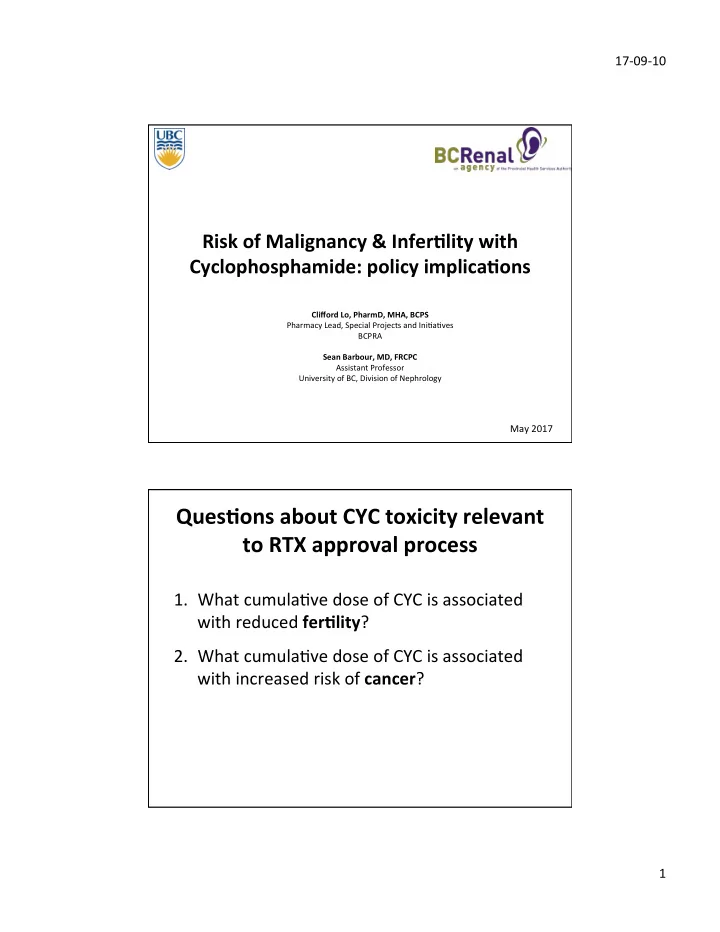

17-09-10 Risk of Malignancy & Infer3lity with Cyclophosphamide: policy implica3ons Clifford Lo, PharmD, MHA, BCPS Pharmacy Lead, Special Projects and Ini<a<ves BCPRA Sean Barbour, MD, FRCPC Assistant Professor University of BC, Division of Nephrology May 2017 Ques3ons about CYC toxicity relevant to RTX approval process 1. What cumula<ve dose of CYC is associated with reduced fer3lity ? 2. What cumula<ve dose of CYC is associated with increased risk of cancer ? 1
17-09-10 Cyclophosphamide Pharmacology CYC’s effect on the menstrual cycle: • Toxic to growing ovarian follicles • Accelerates deple<on of ovarian follicles leading to amenorrhea/ premature menopause CYC’s effect on spermatogenesis: • Most toxic to rapidly prolifera<ng type B spermatogonium CYC alkylates guanine: • Severity and dura<on of gonadal 1. Prevents cell division by inhibi<ng DNA damage correlates with destruc<on of synthesis/transcrip<on stem cells (type A spermatogonium) 2. Causes DNA muta<on 3. Causes cell apoptosis Literature Review Medline 1946 to October 2016 MeSH: cyclophosphamide, ovarian failure, azoospermia, lupus, vasculi<s Iden%fied 57 papers and appraised 23 When interpre3ng the data, please keep in mind: • Pa<ents of any age may have baseline deficiencies in semen quality, have subclinical ovarian damage or have diminished ovarian reserve • Fer<lity in females will decline in the last 2 decades prior to menopause (average age of menopause = 51) – In a healthy 40 yo who is trying, there is a < 5% chance of becoming pregnant per cycle – Most women in their mid-40s are unable to have a successful pregnancies [ASRM 2012] • Amenorrhea or azoospermia may result from stress to the body, such as during acute illness – 54% of SLE pa<ents (age 18-39) experienced amenorrhea without CYC [Pasoto et al. 2002] 2
17-09-10 Amenorrhea 2 o CYC There are 2 predominant approaches used in evalua<on: 1. Average cumula3ve dose at onset of amenorrhea < 20 yo 20 - 30 yo 31 - 40 yo > 40 yo Keep cumula<ve 20 g 15 g 10 g 5 g dose under è 2. % of pa3ents who experienced amenorrhea when treated with a certain CYC regimen (e.g. 0.5 - 1 g/m 2 IV monthly) 1.73 m 2 or 75 kg < 20 yo 20 to 30 yo 31 to 40 yo > 40 yo individual 23 – 45% 75 – 83% 10 - 20 g 0% 6% 15 – 30 g 4% 27 - 29% 54 - 62% No data Azoospermia 2 o CYC The literature reports azoospermia by average cumula<ve dose in pre/post pubertal males rather than by age categories. • Incidence of azoospermia in prepubertal males (75 kg) according to cumula<ve dose: ≤ 30 g of CYC > 30 g of CYC Azoospermia 0 30% • Incidence of azoospermia in sexually mature males (75 kg) according to cumula<ve dose: ≤ 7.5 g 7.5 - 15 g 16 - 20 g 21 - 30 g > 30 g Azoospermia 50 – 100% 80 – 100% 0 20 - 100% 100% 3
17-09-10 MALIGNANCY 2 o CYC Leukemia: • IRR 59 (95% CI; 12 to 172) with > 36 g of exposure Non-melanoma skin cancer: • IRR 3.9 (95% CI; 1.4 to 8.4) with 1 - 36 g of exposure Bladder cancer: • Risk is non-significant when exposure < 20 g • Risk increases 6.3x aker 20 to 49 g – 3 more cases per 100 pa<ents treated • Risk increases 14.5x aker 50 g – 7 more cases per 100 pa<ents treated Modifica3ons to RTX funding criteria • Proposed approximate guidelines for cumula<ve prior CYC exposure: • Fer<lity concern women: 10 g if age < 40, age > 40 fer<lity not considered • Fer<lity concern men: 10 g any age • Malignancy concern: 20 g • These are not hard cut-offs • Each applica<on will con<nue to be adjudicated on a case-by-case basis 4
17-09-10 Modifica3ons to RTX funding criteria • Recognize these are very sensi<ve and controversial topics • Chosen very conserva<ve dose thresholds from the literature • Goals: • Transparent and standardized approach to adjudica<ng RTX applica<ons especially for sensi<ve indica<ons • Mi<gate rising costs from “controversial” indica<ons for RTX 5
Recommend
More recommend